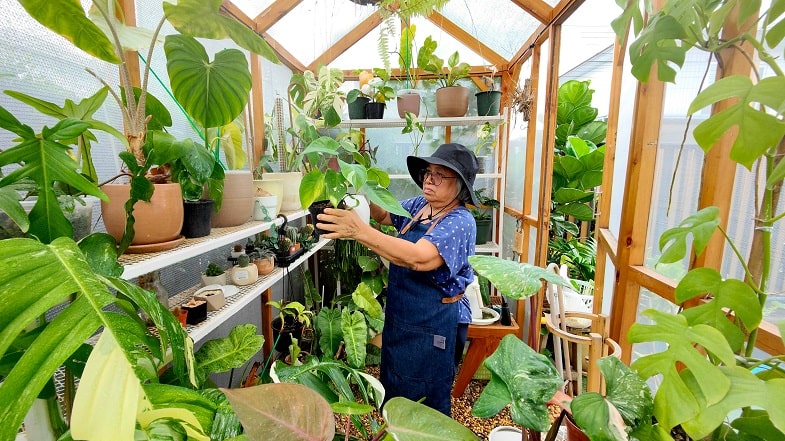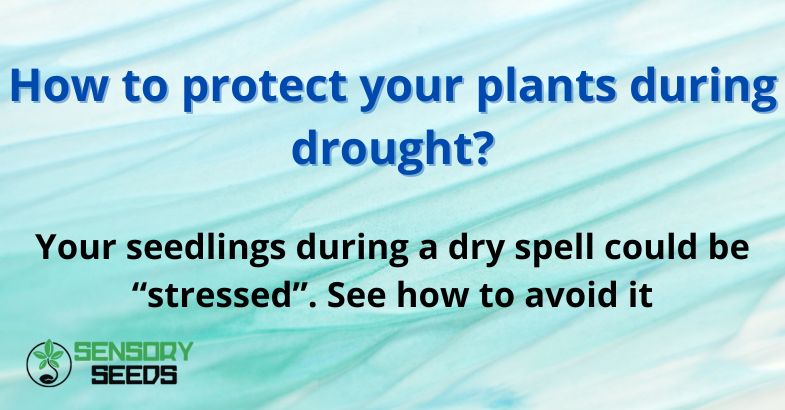Published on: 05/07/2024
Your seedlings during a dry spell could be “stressed”. See how to avoid it
As we all know, water affects the growth and health of plants, including cannabis plants. However, with climate change and rising temperatures, drought is becoming an increasingly common problem.
This article will explore how to protect your cannabis plants from water stress during periods of drought.
What is water stress and when does it occur?
Water stress occurs when plants receive less water than they need for their optimal development. This can lead to a number of problems, including reduced growth, decreased yield and, in the most severe cases, plant death. Drought can exacerbate these problems, making preventive and corrective measures even more essential.
What are the effects of drought on plants?
Reducing growth
Lack of water directly affects the plant’s ability to perform photosynthesis, the process by which plants produce energy. Without an adequate amount of water, photosynthesis slows down, reducing overall plant growth.
Read also: How much water does a cannabis plant need?


Decreased yield
Cannabis yield is closely linked to the health of the plant. Plants stressed by the absence of water will produce fewer flowers and, consequently, fewer cannabinoids. This can compromise both the quantity and quality of the harvest.
Increased vulnerability to diseases and pests
Plants under water stress are more vulnerable to diseases and pests. Water is essential to keep the plant healthy and hardy; without it, the plant’s immune system weakens, making it easier for pathogens and harmful insects to attack.
What strategies can we adopt to protect plants during drought?
1. Choose drought-resistant varieties
One of the first preventive measures is to select cannabis varieties that are naturally more resistant to drought. Some varieties have been developed to survive in arid environments and require less water to grow.
2. Using effective irrigation techniques
Irrigation is essential to keep plants hydrated. Techniques such as drip irrigation can be very effective, as they deliver water directly to the plant roots, minimizing water wastage.
- Drip irrigation: this method delivers water slowly and steadily, directly to the root zone. It is particularly useful for maintaining constant soil moisture without saturating the plants.
- Timed irrigation: using timers for irrigation can help ensure that plants receive water regularly, even during periods of water scarcity.
3. Mulching
Mulching consists of covering the soil around plants with organic materials such as straw, dry leaves or compost. This helps conserve soil moisture, reducing evaporation and keeping the roots fresh. Using organic materials not only helps retain moisture, but also adds nutrients to the soil as they decompose. A layer of about 5-10 cm should be applied around the base of the plants, but avoid directly covering the stem to prevent rot.
4. Improving soil quality
Good quality soil can retain water better and provide plants with the nutrients they need. Adding compost or other organic soil conditioners can improve the soil structure, increasing its water retention capacity. Compost enriches the soil with organic matter, improving its ability to retain moisture.
5. Pruning and thinning
Plant management during dry periods is crucial. This includes pruning regularly to remove non-essential plant parts, reducing transpiration and, thus, the amount of water lost. In fact, removing leaves and branches that do not receive much light can help reduce water loss, while thinning plants helps air circulation and reduces the risk of developing fungal diseases.
Read also: What are the growth phases of the cannabis plant?


6. Constant monitoring
Constantly monitoring plants and soil is essential to detect signs of water stress at an early stage. Using tools such as hygrometers to measure soil moisture can help determine when watering is necessary.
Innovative approaches to water management
Rainwater harvesting systems
Implementing rainwater harvesting systems can provide an alternative source of irrigation. These systems collect and store rainwater for use during dry periods. Among the various collection systems, tanks can be installed to collect water from gutters and then filter it to remove any contaminants before using it for irrigation.
Sub-surface irrigation
This method consists of placing the irrigation pipes below the soil surface, close to the roots of the plants, at a depth of approximately 10-20 cm. This method reduces evaporation and water wastage, and ensures that the water reaches the roots directly, thus increasing irrigation efficiency,
Conclusion
Protecting cannabis plants from water stress during drought periods is essential. Adopting strategies such as effective irrigation techniques, mulching, soil improvement and careful plant management will not only help keep plants healthy and productive, but also contribute to a more sustainable use of water resources. As global temperatures rise and drought events become more frequent, it becomes increasingly important to prepare for and adopt agricultural practices that can mitigate the effects of water stress.
If you also want to grow your own seedlings, visit our SensorySeeds site and buy your favourite seeds!









